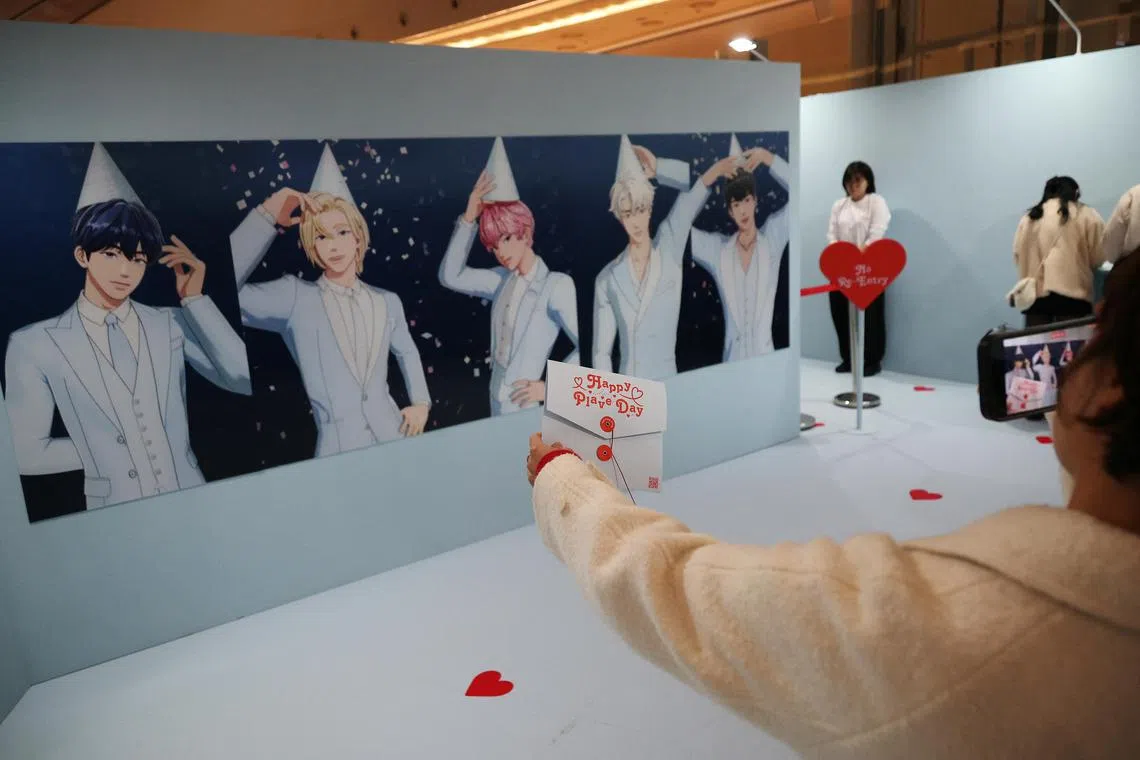Virtual boy band Plave mix K-pop and technology to charm fans
Sign up now: Get ST's newsletters delivered to your inbox

A fan of virtual K-pop boy band Plave takes a photos with portraits of members of Plave at a pop-up store in Seoul on March 7.
PHOTO: REUTERS
Follow topic:
SEOUL – The five members of one of K-pop’s trendiest groups, Plave, have appeared on television and held concerts. One of their songs has even secured a place in the prestigious Billboard Global 200, an international music chart.
On paper, they seem like any other K-pop sensation, except they are two-dimensional avatars with songs and content that have racked up more than 470 million views on YouTube.
The boy band – consisting of Yejun, Noah, Eunho, Bamby and Hamin – told Reuters they want to be globally recognised like K-pop sensation BTS.
“We don’t often get to meet our fans, so when we meet them at a concert, we get very excited,” said Bamby, who has pink hair and eyes. “They cheer for us together... We make an all-out effort when we perform.”
Unlike many other virtual groups, Plave’s label Vlast says the avatars are controlled by humans, using motion-capture and other technology to relay their actions and singing.
However, Vlast keeps the identity of the humans behind the avatars a secret, so they spoke to Reuters on condition of anonymity.
Since their debut in 2023, Plave have broken streaming records and topped music charts in South Korea with their latest album Caligo Pt.1, released in February, selling more than one million copies in one week.

A fan of virtual K-pop boy band Plave shops fan goods at a pop-up store in Seoul on March 7.
PHOTO: REUTERS
“For concerts, we connect our in-house motion-capture studio directly to the actual concert venue in real time,” Vlast chief executive Lee Sung-gu said in an e-mail. “This set-up includes a feedback system that allows the members to see fan reactions from the concert venue as they perform.”
Despite the rise of artificial intelligence (AI), Mr Lee says his company plans to expand on the motion-capture technique. “It’s our unique strength,” he added.
There is little difference between virtual and real-life idols to Ms Chang Ya-han, a 30-year-old Taiwanese fan who learnt about Plave in an Instagram video.
“The love they give us, the way they drive us to become better, or how I wake up every day wanting to see them – that feeling is the same,” she said at a crowded fan event in Seoul.
Vlast describes itself as a “virtual entertainment” start-up and says it received equity investments from K-pop labels Hybe and YG Plus early in 2024.

Ahn Jin-yeong, a fan of virtual K-pop boy band Plave, takes a selfie with fan goods at a pop-up store in Seoul, South Korea on March 7, 2025.
PHOTO: REUTERS
In recent years, technology such as AI and the metaverse are increasingly embraced by the multi-million-dollar K-pop industry.
According to Seoul-based music critic Kim Do-heon, Plave’s success hinges on their interaction with fans.
“It’s expensive to go to an idol group’s concert and you need to use a paid messaging app to interact with them these days,” he said. “But the accessibility of cyber singers makes it much easier to like them.” REUTERS

